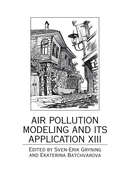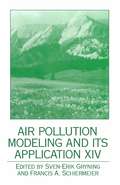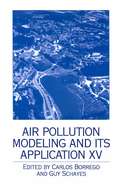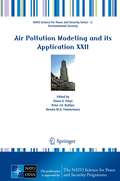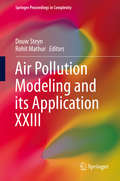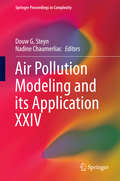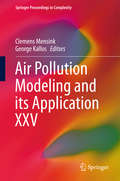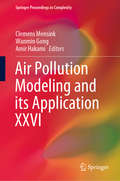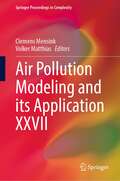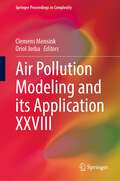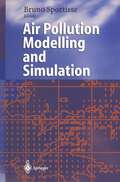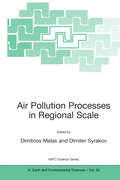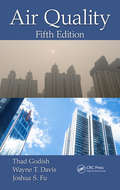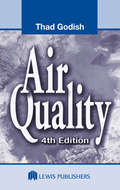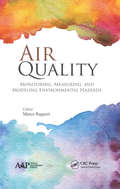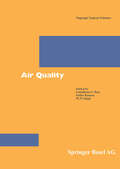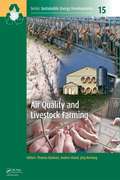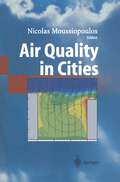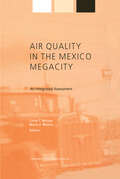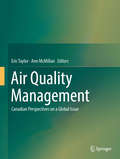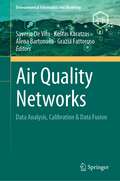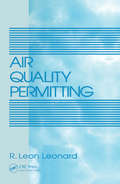- Table View
- List View
Air Pollution Modeling and Its Application XIII
by Sven-Erik Gryning Ekaterina BatchvarovaThe ITM conference series has always had a strong spirit of cooperation under the NATO/CCMS umbrella, and with the considerable interest fram Partner countries to participate in the ITM conferences, it provides an excellent opportunity to create ties between scientists. Whereas all previous ITM conferences have taken place in NATO countries, the 23rd ITM takes place in a Cooperative Partner country, Bulgaria, and is hosted by the National Institute of Meteorology and Hydrology, Bulgarian Academy of Sciences. This fact reflects a general wish for a closer connection and collaboration among scientists fram Partner and NATO countries. This volume contains the papers from the 23rd NATO/CCMS International Technical Meetings on Air Pollution Modelling and Its Application, being held September 28 - October 2, 1998, at Riviera Holiday Club, Varna, Bulgaria. It was attended by 120 participants from 30 countries. Thanks are due to all who made it possible to plan, carry through, and follow up the meeting, and to the participants who made the conference so successful. Special thanks are due to the sponsoring institutions: ATO/CCMS EURASAP RIS0 BAS 3M NATO/CCMS - Committee on the Challenges of Modem Society EURASAP - European Association for the Science of Air Pollution RIS0 - Ris0 National Laboratory, Denmark NIMH - National Institute of Meteorology and Hydralogy, Bulgaria BAS - Bulgarian Academy of Sciences 3M Representation office, Bulgaria Prestige Business Ltd. , Bulgaria The excellent collaboration with CIM (Company for International Meetings Ltd.
Air Pollution Modeling and its Application XIV
by Sven-Erik Gryning Francis A. SchiermeierProceedings of the Millennium NATO/CCMS International Technical Meeting on Air Pollution Modeling and its Application, held May 15-19 in Boulder, Colorado. This volume is the latest in a series of proceedings dating back to 1971. The book addresses the problem of air pollution and reports the latest findings and developments in air pollution modeling, from a truly international list of contributors.
Air Pollution Modeling and its Application XV
by Carlos Borrego Guy SchayesIn 1969 the North Atlantic Treaty Organization (NATO) established the Committee on Challenges of Modern Society (CCMS). The subject of air pollution was from the start, one of the priority problems under study within the framework of various pilot studies undertaken by this committee. The organization of a periodic conference dealing with air pollution modelling and its application has become one of the main activities within the pilot study relating to air pollution. These international conferences were successively organized by the United States (first five); Federal Republic of Germany (five); Belgium (five); The Netherlands (four) and Denmark (five). With this one Portugal takes over the duty. This volume contains the papers and poster abstracts presented at the NATO/CCMS International Technical Meeting on Air Pollution Modelling and Its Application held in Louvain-la-Neuve, Belgium, during 15-19 October 2001. This ITM was jointly organized by the University of Aveiro, Portugal (Pilot country) and by the Catholic University of Louvain, Belgium (host country). The ITM was attended by 78 participants representing 26 countries from Western and Eastern Europe, North and South America, Asia, Australia and Africa. The main topics of this ITM were : Role of Atmospheric Models in Air Pollution Policy and Abatement Strategies; Integrated Regional Modelling; Global and Long-Range Transport; Regional Air Pollution and Climate; New Developments; and Model Assessment and Verification.
Air Pollution Modeling and its Application XXII (NATO Science for Peace and Security Series C: Environmental Security)
by Douw G. Steyn Peter J.H. Builtjes Renske M.A. TimmermansRecent developments in air pollution modeling and its application are explored here in contributions by researchers at the forefront of their field. The book is focused on local, urban, regional and intercontinental modeling; data assimilation and air quality forecasting; model assessment and evaluation; aerosol transformation; the relationship between air quality and human health and the interaction between climate change and air quality. The work will provide useful reference material for students and professors interested in air pollution modeling at the graduate level as well as researchers and professionals involved in developing and utilizing air pollution models.
Air Pollution Modeling and its Application XXIII (Springer Proceedings in Complexity)
by Douw Steyn Rohit MathurRecent developments in air pollution modelling are explored as a series of contributions from researchers at the forefront of their field. This newest contribution on air pollution modelling and its application is focused on local, urban, regional and intercontinental modelling; data assimilation and air quality forecasting; model assessment and evaluation; aerosol transformation. Additionally, this work also examines the relationship between air quality and human health and the effects of climate change on air quality. The work derives from a series of papers presented at the 33rd International Technical Meeting on Air Pollution Modelling and its Application held in Miami, USA, August 27 - 31, 2013. The book is intended as reference material for students and professors interested in air pollution modelling at the graduate level as well as researchers and professionals involved in developing and utilizing air pollution models.
Air Pollution Modeling and its Application XXIV (Springer Proceedings in Complexity)
by Douw G. Steyn Nadine ChaumerliacCurrent developments in air pollution modelling are explored as a series of contributions from researchers at the forefront of their field. This newest contribution on air pollution modelling and its application is focused on local, urban, regional and intercontinental modelling; data assimilation and air quality forecasting; model assessment and evaluation; aerosol transformation. Additionally, this work also examines the relationship between air quality and human health and the effects of climate change on air quality. The work is comprised of selected papers presented at the 34th International Technical Meeting on Air Pollution Modelling and its Application held in Montpellier, France in 2015. The book is intended as reference material for students and professors interested in air pollution modelling at the graduate level as well as researchers and professionals involved in developing and utilizing air pollution models.
Air Pollution Modeling and its Application XXV (Springer Proceedings in Complexity)
by Clemens Mensink George KallosCurrent developments in air pollution modelling are explored as a series of contributions from researchers at the forefront of their field. This newest contribution on air pollution modelling and its application is focused on local, urban, regional and intercontinental modelling; long term modelling and trend analysis; data assimilation and air quality forecasting; model assessment and evaluation; aerosol transformation. Additionally, this work also examines the relationship between air quality and human health and the effects of climate change on air quality.This Work is a collection of selected papers presented at the 35th International Technical Meeting on Air Pollution Modeling and its Application, held in Chania (Crete), Greece, Oct 3-7, 2016.The book is intended as reference material for students and professors interested in air pollution modelling at the graduate level as well as researchers and professionals involved in developing and utilizing air pollution models.
Air Pollution Modeling and its Application XXVI (Springer Proceedings in Complexity)
by Clemens Mensink Wanmin Gong Amir HakamiCurrent developments in air pollution modeling are explored as a series of contributions from researchers at the forefront of their field. This newest contribution on air pollution modeling and its application is focused on local, urban, regional and intercontinental modeling; emission modeling and processing; data assimilation and air quality forecasting; model assessment and evaluation; atmospheric aerosols. Additionally, this work also examines the relationship between air quality and human health and the effects of climate change on air quality.This work is a collection of selected papers presented at the 36th International Technical Meeting on Air Pollution Modeling and its Application, held in Ottawa, Canada, May 14-18, 2018.The book is intended as reference material for students and professors interested in air pollution modeling at the graduate level as well as researchers and professionals involved in developing and utilizing air pollution models.
Air Pollution Modeling and its Application XXVII (Springer Proceedings in Complexity)
by Clemens Mensink Volker MatthiasThis book is intended as reference material for students and professors interested in air pollution modeling at the graduate level as well as researchers and professionals involved in developing and utilizing air pollution models. Current developments in air pollution modeling are explored as a series of contributions from researchers at the forefront of their field. This newest contribution on air pollution modeling and its application is focused on local, urban, regional and intercontinental modeling; emission modeling and processing; data assimilation and air quality forecasting; model assessment and evaluation; aerosol transformation. Additionally, this work also examines the relationship between air quality and human health and the effects of climate change on air quality.This work is a collection of selected papers presented at the 37th International Technical Meeting on Air Pollution Modeling and its Application, held in Hamburg, Germany, September 23-27, 2019.
Air Pollution Modeling and its Application XXVIII (Springer Proceedings in Complexity)
by Clemens Mensink Oriol JorbaThis book states that current developments in air pollution modeling are explored as a series of contributions from researchers at the forefront of their field. This newest contribution on air pollution modeling and its application is focused on local, urban, regional and intercontinental modeling; long-term modeling and trend analysis; data assimilation and air quality forecasting; model assessment and evaluation; aerosol transformation. Additionally, this work also examines the relationship between air quality and human health and the effects of climate change on air quality.This work is a collection of selected papers presented at the 38th International Technical Meeting on Air Pollution Modeling and its Application, held in Barcelona, Spain, Oct 18–22, 2021. The book is intended as reference material for students and professors interested in air pollution modeling at the graduate level as well as researchers and professionals involved in developing and utilizing air pollution models.
Air Pollution Processes in Regional Scale (NATO Science Series: IV: #30)
by Dimitrios Melas Dimiter SyrakovAn understanding of long-range transport of air pollutants in the atmosphere requires a knowledge of the relevant atmospheric dynamic and chemical processes active at the regional scale as well as the temporal and spatial distribution of emissions. Numerical modeling is the most efficient way to determine the atmospheric transport, photochemistry and deposition pathways. The book therefore discusses the physical and chemical processes that determine regional air pollution and presents the relevant modeling techniques to describe the different atmospheric processes that are active at that scale.
Air Quality
by Thad Godish Wayne T. Davis Joshua S. FuThe fifth edition of a bestseller, Air Quality provides students with a comprehensive overview of air quality, the science that continues to provide a better understanding of atmospheric chemistry and its effects on public health and the environment, and the regulatory and technological management practices employed in achieving air quality goals.
Air Quality
by Thad Godish Joshua S. FuOzone-destroying chemicals, greenhouse gases, and dangerous airborne substances that were once thought to be benign are the most urgent issues facing air pollution control experts. Students need a thorough, updated reference that explores these current trends while also covering the fundamental concepts of this emerging discipline. A new re
Air Quality: Monitoring, Measuring, and Modeling Environmental Hazards
by Marco RagazziThis title includes a number of Open Access chapters. This new compendium provides a nuanced look at monitoring, measuring, and modeling air quality pollution in conjunction with its effects on public health and the environment. Air pollution has been proven to be a major environmental risk to health. Protecting and improving air quality requires knowledge about the types and levels of pollutants being emitted. It also requires the best possible measurement and monitoring capabilities. The chapters in this volume serve as a foundation for monitoring, measuring, and modeling air pollution.
Air Quality: Monitoring, Measuring, and Modeling Environmental Hazards
by Marco RagazziThis title includes a number of Open Access chapters. This new compendium provides a nuanced look at monitoring, measuring, and modeling air quality pollution in conjunction with its effects on public health and the environment. Air pollution has been proven to be a major environmental risk to health. Protecting and improving air quality requires knowledge about the types and levels of pollutants being emitted. It also requires the best possible measurement and monitoring capabilities. The chapters in this volume serve as a foundation for monitoring, measuring, and modeling air pollution.
Air Quality (Pageoph Topical Volumes)
by Gandikota V. Rao Sethu Raman M. P. SinghThis volume, "Air Quality", contains many original findings on biomasss fires, transboundary pollution and associated haze and their impacts on health, biodiversity and economy and thus is expected to be a source book for research in South East Asia. Many of the results presented in this volume pertain to this region and are thus available under one ' roof.' Some papers could be discussed in graduate level classes dealing with Air Pollution, Air Quality, Cloud Physics and Biophysics. The scientific community will find this book a useful addition to their personal and institutional libraries.
Air Quality and Livestock Farming (Sustainable Energy Developments)
by Thomas Banhazi Andres Aland Jörg HartungAir quality has a direct influence on health, welfare and production performance of livestock as the high concentrations of noxious gases, dust and airborne microorganisms are likely to reduce production efficiency and the general welfare of farm animals. Long term exposure to particulates in livestock buildings might also affect the respiratory health of farm workers. Dust in animal buildings contains many biologically active substances such as bacteria, fungi, endotoxins and residues of antibiotics (as a result of veterinary treatments) that are suspected to be hazardous to human health. Furthermore, air pollutants emitted from livestock buildings can reduce air, water and soil quality and can potentially undermine the health of nearby residents. Airborne emissions include ammonia, methane, nitrous oxide, particulates like dust and microorganisms. In addition, other potentially harmful substances such as heavy metals, antibiotic residues and components of disinfectants might be also emitted from livestock building that are potentially damaging to ecosystems. In this book, key aspects of agricultural air quality, such as monitoring, managing and reducing airborne pollutants in and around livestock facilities are reviewed. Features: addressing the raising awareness of the importance of optimal health and welfare for lifestock species with contributions from international specialists and researchers providing up-to-date information for professionals involved in modern animal producti This book will be useful for farming professionals, academics, students, policy makers, business leaders, regulatory bodies and agricultural consultants.
Air Quality and Livestock Farming (Sustainable Energy Developments)
by Thomas Banhazi Andres Aland Jörg HartungAir quality has a direct influence on health, welfare and production performance of livestock as the high concentrations of noxious gases, dust and airborne microorganisms are likely to reduce production efficiency and the general welfare of farm animals. Long term exposure to particulates in livestock buildings might also affect the respiratory health of farm workers. Dust in animal buildings contains many biologically active substances such as bacteria, fungi, endotoxins and residues of antibiotics (as a result of veterinary treatments) that are suspected to be hazardous to human health. Furthermore, air pollutants emitted from livestock buildings can reduce air, water and soil quality and can potentially undermine the health of nearby residents. Airborne emissions include ammonia, methane, nitrous oxide, particulates like dust and microorganisms. In addition, other potentially harmful substances such as heavy metals, antibiotic residues and components of disinfectants might be also emitted from livestock building that are potentially damaging to ecosystems. In this book, key aspects of agricultural air quality, such as monitoring, managing and reducing airborne pollutants in and around livestock facilities are reviewed. Features: addressing the raising awareness of the importance of optimal health and welfare for lifestock species with contributions from international specialists and researchers providing up-to-date information for professionals involved in modern animal producti This book will be useful for farming professionals, academics, students, policy makers, business leaders, regulatory bodies and agricultural consultants.
Air Quality in Cities
by Nicolas MoussiopoulosUrban areas are major sources of air pollution. Pollutant emissions affecting air quality in cities are considered to have adverse consequences for human health. Public and government concern about environmental issues arising from urban air pollution has increased over the last decades. The urban air pollution problem is widespread throughout the world and it is important to find ways of eliminating or at least reducing the risks for human health. The fundamentals of the physical and chemical processes occurring during air pollutant transport in the atmosphere are nowadays understood to a large extent. In particular, modelling of such processes has experienced a remarkable growth in the last decades. Monitoring capabilities have also improved markedly in the most urban areas around the world. However, neither modelling nor monitoring can solve urban air pollution problems, as they are only a first step in improving useful information for future regulations. The defining of efficient control strategies can not be achieved without a clear knowledge of the complete pollution process, i.e. emission, atmospheric transport and transformation, and deposition at the receptor. Improving our ability to establish valid urban scale source-receptor relation ships has been the objective of SA TURN, one of the 14 subprojects of EURO TRAC-2. Similar to the other subprojects of this co-ordinated environmental pro ject within the EUREKA initiative, SA TURN brought together international groups of scientists to work on problems directly related to atmospheric chemistry and physics. The present volume summarises the scientific results of SATURN.
Air Quality in the Mexico Megacity: An Integrated Assessment (Alliance for Global Sustainability Bookseries #2)
by Mario J. Molina Luisa T. MolinaIn this book, experts in atmospheric sciences, human health, economics, social and political sciences contribute to an integrated assessment of the complex elements needed to structure air quality policy in the 21st century. The analysis is developed through a case study of the Mexico City Metropolitan Area - one of the world's largest megacities in which air pollution grew unchecked for decades. The international research team is led by Luisa T. and Mario J. Molina, Nobel Laureate in Chemistry. Improvements in Mexico City's air quality in the last decade testifies to the power of determined and enlightened policy making, and throws into relief the tough problems that remain to be solved.The volume's first six chapters, including the contributions of over 50 distinguished scholars from Mexico and the US, outline the fundamental areas of knowledge policy makers must accommodate. The message is that only good science and well-chosen technologies can direct the way to corrective regulatory measures; but without strong commitment from government, no amount of science or technology can help.
Air Quality Management: Canadian Perspectives on a Global Issue
by Eric Taylor Ann McMillanThis book provides a wide overview of the issues related to managing of air quality in Canada. Learn about the air issues that have caused impacts to ecosystems or human health and hence been targeted to be managed. Discover how Canada’s national governance involving a federal government along with provincial and territorial governments impacts the air quality management process. Understand how Canadians manage their air quality in context with the USA, their largest and closest neighbour. Benefit from the experience of 43 of Canada’s most experienced air quality management professionals who share their insights into the state of air quality in Canada today, how it is managed, as well as giving a glimpse into the future.
Air Quality Networks: Data Analysis, Calibration & Data Fusion (Environmental Informatics and Modeling)
by Saverio De Vito Kostas Karatzas Alena Bartonova Grazia FattorusoThis volume offers expert contributions proposing new and recently set scientific standards for smart air quality (AQ) networks data processing, along with results obtained during field deployments of pervasive and mobile systems. The book is divided into 5 main sections; 1) future air quality networks, 2) general data processing techniques, 3) field deployments performances, 4) special applications, and 5) cooperative and regulatory efforts. The authors offer different sources of data for the production of trustworthy insights, including spatio-temporal predictive AQ maps meant to boost citizen awareness, and informed participation in remediation and prevention policies. Readers will learn about the best and most up-to-date practices for measuring and assessing air quality, while also learning about current regulatory statuses regarding air quality technology design and implementation. The book will be of interest to air quality regulatory agencies, citizen science groups, city authorities, and researchers and students working with air quality sensors and geostatistics.
Air Quality Permitting
by R. Leon LeonardThis practical book covers all of the fundamentals for obtaining air quality permits for new sources of air pollutant emissions and Title V operating permits for operating sources. Written for facility environmental managers, consultants, and air quality regulatory staff, Air Quality Permitting provides a thorough discussion on the strategies of successfully permitting a facility.
Air Quality Permitting
by R. Leon LeonardThis practical book covers all of the fundamentals for obtaining air quality permits for new sources of air pollutant emissions and Title V operating permits for operating sources. Written for facility environmental managers, consultants, and air quality regulatory staff, Air Quality Permitting provides a thorough discussion on the strategies of successfully permitting a facility.
